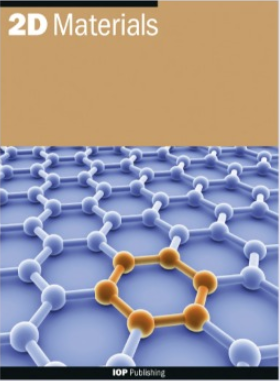Power efficient MoS2 synaptic devices based on maxwell-wagner interfacial charging in binary oxides
IF 4.3
3区 材料科学
Q2 MATERIALS SCIENCE, MULTIDISCIPLINARY
引用次数: 0
Abstract
Abstract Synaptic devices with tunable weight hold great promise in enabling non-von Neumann architecture for energy efficient computing. However, conventional metal-insulator-metal based two-terminal memristors share the same physical channel for both programming and reading, therefore the programming power consumption is dependent on the synaptic resistance states and can be particularly high when the memristor is in the low resistance states. Three terminal synaptic transistors, on the other hand, allow synchronous programming and reading and have been shown to possess excellent reliability. Here we present a binary oxide based three-terminal MoS 2 synaptic device, in which the channel conductance can be modulated by interfacial charges generated at the oxide interface driven by Maxwell-Wagner instability. The binary oxide stack serves both as an interfacial charge host and gate dielectrics. Both excitatory and inhibitory behaviors are experimentally realized, and the presynaptic potential polarity can be effectively controlled by engineering the oxide stacking sequence, which is a unique feature compared with existing charge-trap based synaptic devices and provides a new tuning knob for controlling synaptic device characteristics. By adopting a three-terminal transistor structure, the programming channel and reading channel are physically separated and the programming power consumption can be kept constantly low (∼50 pW) across a wide dynamic range of 10 5 . This work demonstrates a complementary metal oxide semiconductor compatible approach to build power efficient synaptic devices for artificial intelligence applications.基于二元氧化物中麦克斯韦-瓦格纳界面充电的高能效MoS2突触器件
具有可调重量的突触器件在实现节能计算的非冯·诺伊曼架构方面具有很大的前景。然而,传统的基于金属-绝缘体-金属的双端忆阻器在编程和读取时共用相同的物理通道,因此编程功耗取决于突触电阻状态,当忆阻器处于低电阻状态时,编程功耗可能特别高。另一方面,三个终端突触晶体管允许同步编程和读取,并已被证明具有优异的可靠性。在这里,我们提出了一个基于二元氧化物的三端MoS 2突触器件,其中通道电导可以通过由麦克斯韦-瓦格纳不稳定性驱动的氧化物界面产生的界面电荷来调制。二元氧化物堆既作为界面电荷宿主又作为栅极介电体。在实验中实现了兴奋性和抑制性行为,并且通过设计氧化物堆叠顺序可以有效地控制突触前电位极性,这是现有基于电荷阱的突触器件的独特之处,为控制突触器件特性提供了新的调节旋钮。通过采用三端晶体管结构,编程通道和读取通道在物理上是分开的,编程功耗可以在10.5的宽动态范围内持续保持低(~ 50 pW)。这项工作展示了一种互补的金属氧化物半导体兼容方法来构建用于人工智能应用的节能突触器件。
本文章由计算机程序翻译,如有差异,请以英文原文为准。
求助全文
约1分钟内获得全文
求助全文
来源期刊

2D Materials
MATERIALS SCIENCE, MULTIDISCIPLINARY-
CiteScore
10.70
自引率
5.50%
发文量
138
审稿时长
1.5 months
期刊介绍:
2D Materials is a multidisciplinary, electronic-only journal devoted to publishing fundamental and applied research of the highest quality and impact covering all aspects of graphene and related two-dimensional materials.
 求助内容:
求助内容: 应助结果提醒方式:
应助结果提醒方式:


